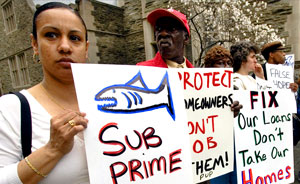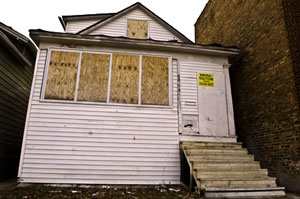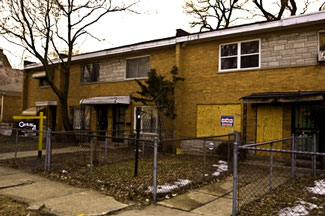Bad loans, vacant properties, falling home values, prices signs of a continued crisis

LOS ANGELES (FinalCall.com) – The presidential race, rising costs of oil and gas, extreme weather and food shortages offer enough to hold one’s attention, but eyes remained glued on America’s mortgage crisis. Home values have dropped again, homes sales are lagging, home equity credit lines are drying up and lenders have tightened standards for getting home loans.
Blacks have seen neighborhoods hit hard by foreclosures that have devastated families, left blocks of seemingly abandoned homes, and equity that once was considered a safety net for disasters, isn’t much security anymore. The loss of Black wealth from the crisis has been estimated into billions of dollars.
“This could be a fairly unique crisis in that it should, unlike Katrina that particularly devastated the poorest of the Black community, this hurricane of subprime loans and of massive debt foreclosures might hit more so the Black middle class and upper middle class because these are the people who are often times more likely targeted by the subprime lending industry as people who had income and could be talked into a refinance, which is why you’re seeing places like Atlanta or Prince Georges County, the wealthiest Black county of the country, being particularly devastated by this crisis,” said Dedrick Muhammad, of the Institute for Policy Studies in Washington, D.C.

According to the National Association of Realtors, home re-sales increased slightly between April and May. But new home sales dropped 2.5 percent in May, which means it can take more than 10 months to sell current new homes on the market, said the U.S. Census Bureau and the Department of Housing and Urban Development.
Skittish homebuyers are seeing more properties on the market, but are afraid to buy because the home’s worth may fall, say analysts. Standard & Poor’s, a U.S. corporate credit rating agency, reports that Las Vegas, Miami and Phoenix are the weakest housing markets with home values falling by about 25 percent.
Of California’s 113,676 foreclosure notices, the highest increase in 15 years, more than 110,000 pertained to homes, while the others were for defaults on multiple loans including primary mortgages and lines of credit, according to DataQuick, a California-based real estate information and data company.
There are some 10,000 vacant or abandoned properties in Cleveland, Ohio alone.
Kristopher Harsh, head organizer with ACORN Cleveland (Association of Community Organizations for Reform Now) said the last time home values dropped this far was in the 1930s. Many foreclosed homes are sold for as little as $2,000 to $5,000. They are worth about that much because within weeks, the homes are stripped of copper piping and scrap metal.
“They have all the windows shattered, any metal that can be scrapped stripped, and this often means the water in the basement runs until the city can come and shut down the water because they will take the copper pipes right out of the basement while the water’s running, so that means there’s foundation damage to many of these houses,” Mr. Harsh said.
The vacant homes are often used by drug addicts and dealers, and in rare occasions the homeless take up residence and are actually good neighbors because they take care of the homes, he said.
In January, Cleveland’s Mayor Frank Jackson filed a lawsuit against 21 major investment banks (including Deutsche Bank Trust Co., Wells Fargo, Ameriquest Mortgage Co., Countrywide Financial Corp., HSBC Holdings, JP Morgan Chase, Washington Mutual Inc., Citigroup Inc., Bank of America Corp., NovaStar Financial Inc., The Bear Stearns Cos., IndyMac Bancorp and Credit Suisse) for enabling the subprime crisis there, he said.
Besides losing funds by boarding up properties, there is added stress on Cleveland’s police and fire departments, which are being called out to more vacant properties.
“I don’t know if it it’s enough heads or the right heads rolling about this. I was glad to see the FBI picking up those Wall Street people. I think most of the criminal activity was done at the highest level among the financiers and heads of mortgage companies who colluded throughout the late ’90s and early part of this decade to turn mortgages into a profitable venture on Wall Street,” he said.
“I sort of look at the local people (bankers and lenders) in a way as fleas on a dog. They’re a nuisance; nobody wants them; but if you want to get rid of them you go for the dog itself. You don’t try to call off a million fleas to get rid of the flea problem, you get rid of the dog,” Mr. Harsh added.
The Illinois and California attorneys general have filed lawsuits against Countrywide Financial Corp. The states are charging that the largest U.S. home loan lender should be held liable for thousands of foreclosures that have hurt economies and wrecked housing markets.
Worst predictions come true

“Assisting homeowners and the mortgage market in the short run is only the first thing that needs to be done,” said Miles Rapoport, president of Demos, a D.C.-based non-profit. “For the long term, we need a set of rules for the mortgage and financial industry that give people confidence that this will never happen again.”
A Demos report, “Beyond the Mortgage Meltdown,” was released June 25 at the National Press Club. Demos senior fellow James Lardner wrote, “The damage has been as bad as anyone imagined so far. Foreclosures, after roughly doubling in the past year, are running at a rate of close to 25,000 a week. That’s an alarming figure in itself, and it points toward the loss of more than two million homes in 2008 and 2009–a number very close to the estimates made by consumer groups (and widely dismissed by lenders) in early 2007,” he noted.
“Many African Americans and Latinos were steered away from safer, lower interest loans by brokers and sales agents who, on top of their commissions, received bonuses for jacking up the interest rate,” Mr. Lardner continued.
“Home equity, at its current total value of $20 trillion, represents the biggest source of wealth for most Americans; that is even more true, by and large, for African Americans and Latinos. As a result, says Citigroup vice president Eric Eve, many families may lose ‘the little bit of wealth (they) have been able to accumulate through homeownership.’”
In their report, “Foreclosed: State of the Dream 2008,” researchers with United for a Fair Economy and the Institute for Policy Studies cited Slavic Village, which is 26 percent Black, as the hardest hit community in the U.S. Last year, it had four of the top 21 zip codes for foreclosure filings; vacated houses were stripped of siding; garbage was dumped in yards; windows were broken; doors were stolen; and crime worsened, the report said.
Refinancing to pay for lifestyles
In late June, the Senate voted 89-3 in favor of a $300 billion mortgage relief bill that would allow the Federal Housing Administration to back home loans for some 400,000 distressed borrowers, but many Black lawmakers are concerned that it does not adequately address the needs of Black homeowners.
Mr. Muhammad, an Institute for Policy Studies senior organizer and research associate, agreed that the bill could do more. Rather than a bill that only curbs the current subprime loan-driven crisis and helping people keep their homes, there needs to be more focus on an entryway into homeownership today, just as there was in the ’40s and ’50s with government-subsidized programs, he argued.
Government critics say the mortgage industry was poorly regulated and when financial pros decided they could make money bundling and selling packages to Wall Street, instead of depending on loan repayments from borrowers, subprime loans soared.
Meanwhile, paychecks remained stagnant, costs have increased, and many people tried to maintain their lifestyles by refinancing their homes, Mr. Muhammad told the Final Call. “It all stems back to racial inequality, the fact that the government has never been willing to invest in the African American community the way it has with the White community and African Americans have been trying to figure out a way to move forward but instead were being set up to be prime targets for this crisis that has now emerged,” Mr. Muhammad added.
Wealth lost as housing bubble bursts
United for a Fair Economy estimates that the total loss of wealth for non-Whites will equal $164 billion to $213 billion for subprime loans over the past eight years. Blacks have lost $71 billion to $92 billion and Latinos lost $75 billion and $98 billion with foreclosures and falling home values.
Blacks are taking another hit because banks are freezing home equity lines of credit. Although the equity line of credit might not have been used, homeowners still had access to it, though their homes were worth less. “Now that makes perfect sense as a business aspect, but try telling a consumer that, a recourse is for people to protect that line by either taking a distribution and make that payment or move up their time table if they planned on using it for renovations,” said Glenda Brass, a Los Angeles-based specialist with Brass & Brass Enterprise and the Multicultural Real Estate Alliance for Urban Change, a non-profit organization.
Individuals and companies promising loan modifications in exchange for exorbitant fees, some as high as $5,500, are also victimizing Blacks, Ms. Brass added.
“How can you in good conscience do that? You have people losing their homes and are taking advantage of them with foreclosure and modification scams? When the country hurts, African Americans hurt more, so we need to be out there, us, helping people more because we gained a lot of wealth over the last five to seven years and we will lose a lot of those gains we’ve made,” she continued.
‘Underwater borrowers’ drowning in debt
In addition to wealth dampened by the subprime crisis, Black children may face academic problems, families may be less engaged in neighborhoods and focused on their environment as the prospect of losing homes shakes up families, advocates said.
Les Christie, a CNNMoney.com writer, reported in a June 24 article that foreclosures are accounting for a higher percentage of home sales than last year. The article also noted that home values had dropped in 20 cities for 21 months in a row. April figures showed the fall was slowing down, it continued.
“Still, plummeting prices could derail some of the foreclosure prevention efforts underway across the nation. As home prices fall, that wipes out home equity, often leaving homeowners underwater, with mortgages worth more than their homes,” the article said. “Some 10 million homeowners are now underwater, according to Economy.com, and that number will continue to grow as home prices plummet. Underwater borrowers have higher rates of foreclosure than those with some home equity, since they can’t tap their homes for cash in case of an emergency. And some owners are simply walking away from homes that have lost so much value rather than continuing to make expensive payments every month.”
“State of the Dream 2008” recommends lowering the ceiling for mortgage deductions, increasing the development of affordable homes, and simplifying homeownership and cutting costs. Many homeowners are hoping pending federal legislation will offer relief.
While reduced home prices and a heavy surplus are luring a few homebuyers back, some analysts recommend renting until things settle down. Renting can be cheaper in the short term, offer flexibility and alleviate the responsibility of taxes and maintenance costs, they say.
Despite the grim state of the U.S. housing market, Ms. Brass said there are opportunities arising for first time home buyers and she expects that the run of foreclosure loans sparked by adjustable mortgage rates will expire by the end of 2009.
“For now, do not accept no for an answer if you are in need of help,” Ms. Brass said.
Other analysts aren’t sure when the mortgage meltdown and its aftermath will end.
“The nation needs to face up to both the immediate and the structural changes that are needed to cushion the impact of the current crisis for homeowners, communities and the nation; to learn from the lessons of this crisis to improve our housing policy, especially by enhancing the supply of quality, well-located affordable rental housing; and to take the regulatory steps to prevent a similar wealth-stripping crisis from happening again,” said Ellen Seidman, a former Clinton administration official who directs the Financial Services and Education Project at the New America Foundation.












